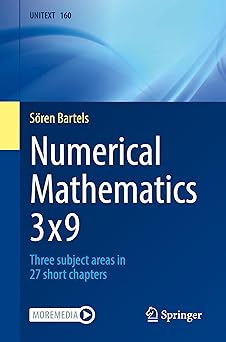
- Author: Sören Bartels
- Series: UNITEXT
- Publisher: Springer
- Publication Date: 05/22/2025
- Number of Pages: 376
- Format: Paperback
- Price: $59.99
- ISBN: 978-3-662-70889-7
- Category: textbook
[Reviewed by Bill Satzer, on 07/01/2025]
This book presents an alternative standard first course in numerical analysis or “numerics” as the author calls it. It is subtitled “Three subject areas in 27 short chapters”. The author’s introduction emphasizes his intent to explore unexpected effects that arise in the course of developing numerical methods. The structure of the text suggest that is was designed to support a course consisting of 27 individual lectures. It includes most of the usual topics that are part of an introductory course, and -here and there – a bit more.
The three subject areas of the subtitle are numerical linear algebra, general concepts and methods that are seen throughout numerical analysis, and numerical solutions of differential equations.
The prologue points to questions that arise in the practical use of mathematics to calculate the results of real processes. It reminds the reader that computer-based numerical methods need to be constructed and evaluated with care. The intention here is to explain how to achieve robust solutions that deal appropriately with the inherent inexactness of computer computation. Along the way, the author addresses computational complexity issues as they relate to achieving a desired accuracy. In practical terms, this can amount to “how many iterations are required to get the accuracy I need?
Numerical linear algebra is an apt place to start. In my time in the supercomputer industry years ago, I was surprised to find how much high-performance computer time was devoted to solutions of systems of linear equations across many applications. Some thought this exceeded 80%. So, it makes sense to start there; many of the basic numerical computing questions arise in this environment. It is here that one sees more easily how uncertainty in the data influence the ability of the algorithms to identify approximately correct solutions.
The nine sections on numerical linear algebra treat all the usual subjects including matrix factorization, singular value decomposition, elimination and iterative methods, as well as eigenvalue problems.
The second of the three parts handles more general aspects of numerical analysis and includes topics like polynomial interpolation, splines, the discrete Fourier transform, and conjugate gradient methods. The third part concentrates of numerical solutions of differential equations using mostly the customary methods and touching on the usual topics.
A fourth part provides a large collection of programs and projects, and then a final part includes introductions to MATLAB, C++ and Python.
This is a well-written and readable introductory text that offers a usefully structured survey of numerical analysis.
Bill Satzer (bsatzer@gmail.com), now retired from 3M Company, spent most of his career as a mathematician working in industry on a variety of applications. He did his PhD work in dynamical systems and celestial mechanics.